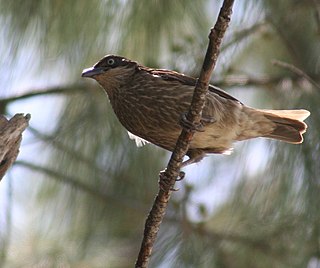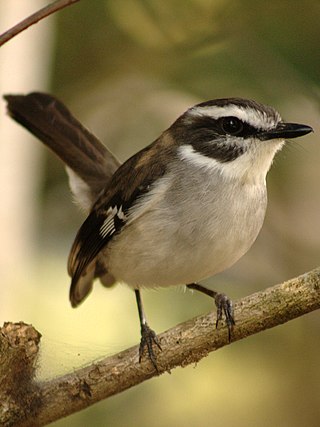
Fantails are small insectivorous songbirds of the genus Rhipidura in the family Rhipiduridae, native to Australasia, Southeast Asia and the Indian subcontinent. Most of the species are about 15 to 18 cm long, specialist aerial feeders, and named as "fantails", but the Australian willie wagtail is a little larger, and, though still an expert hunter of insects on the wing, concentrates equally on terrestrial prey.

Richard Bowdler Sharpe was an English zoologist and ornithologist who worked as curator of the bird collection at the British Museum of natural history. In the course of his career he published several monographs on bird groups and produced a multi-volume catalogue of the specimens in the collection of the museum. He described many new species of bird and also has had species named in his honour by other ornithologists including Sharpe's longclaw and Sharpe's starling.

The Australian rufous fantail is a small passerine bird, most commonly known also as the black-breasted rufous-fantail or rufous-fronted fantail, which can be found in Australia.

The Polynesian starling is a species of starling of the family Sturnidae. It is found in the Samoan Islands, Fiji, Niue, Tonga, the Santa Cruz Islands and Wallis and Futuna. Its natural habitats are subtropical or tropical dry forests and tropical moist forests. Various subspecies exist throughout this wide range, some darker in coloration and some lighter. Its call is a raspy buzz or rattle. Diet is fruit and insects.

Heteromyias is a genus of passerine birds in the Australasian robin family Petroicidae.

Poecilodryas is a genus of passerine birds in the Australasian robin family Petroicidae.

The white-winged fantail or Cockerell's fantail, is a species of bird in the family Rhipiduridae. It is found in the Solomon Islands apart from the island of Malaita in the southeast of the archipelago. The white-gorgeted fantail was formerly considered as a subspecies.

The Arafura fantail, sometimes known as the wood fantail, inhabits the Lesser Sunda Islands, the northern coast of Australia from the Kimberley to the western side of the Cape York Peninsula, including subcoastally in the Top End of the Northern Territory, and southern New Guinea. It is similar to the rufous fantail, from which it has been split taxonomically but, apart from minor overlap in the eastern Moluccas, their geographic ranges are discrete. It is generally duller than the rufous fantail with the rufous colouration more restricted.

The New Zealand fantail is a small insectivorous bird, the only species of fantail in New Zealand. It has four subspecies: R. f. fuliginosa in the South Island, R. f. placabilis in the North Island, R. f. penita in the Chatham Islands, and the now-extinct R. f. cervina formerly on Lord Howe Island. It is also known by its Māori names, pīwakawaka, tīwakawaka or piwaiwaka, and the Chatham Island subspecies by the Moriori name tchitake; the common pied morph is also known as pied fantail, and the uncommon dark morph is also known as black fantail. The species has been considered by many to be conspecific as the grey fantail of Australia and New Caledonia; however, due to significant differences in its calls, many authorities now treat it as a separate species.
The Temotu whistler is a species of bird in the family Pachycephalidae, which is endemic to the Santa Cruz Islands of the Solomon Islands group. It was classified as a separate species in 2016 by the IOC. Two of its subspecies belonged previously to the former white-throated whistler and the nominate subspecies was a subspecies of the Melanesian Whistler.
The white-gorgeted fantail is a species of bird in the family Rhipiduridae. It is endemic to the island of Malaita in the Solomon Islands. It was formerly considered as a subspecies of the white-winged fantail. Its natural habitat is subtropical or tropical moist lowland forests. It is threatened by habitat loss.
The Guadalcanal fantail is a species of bird in the family Rhipiduridae. It is endemic to the island of Guadalcanal in the Solomon Islands. It was formerly considered as a subspecies of the brown fantail. Its natural habitat is subtropical or tropical moist lowland forests. It is threatened by habitat loss.
The Vanuatu streaked fantail is a species of bird in the family Rhipiduridae which is endemic to the Melanesian island of Vanuatu. It was formerly considered to be subspecies of the streaked fantail. Its natural habitat is subtropical or tropical moist lowland forests.
The Fiji streaked fantail is a species of bird in the family Rhipiduridae that is endemic to the islands of Fiji. It was formerly considered to be subspecies of the streaked fantail. Its natural habitat is subtropical or tropical moist lowland forests.
The supertramp fantail is a species of bird in the family Rhipiduridae that is found on the Lesser Sunda Islands, Maluku Islands, Kai Islands and Aru Islands. It was formerly considered to be subspecies of the Arafura fantail. Its natural habitat is subtropical or tropical moist lowland forests.

The Gilolo fantail is a species of bird in the family Rhipiduridae that is endemic to the northern Maluku Islands from Halmahera south to the Obi. The English "Gilolo" is an earlier name for Halmahera. The Gilolo fantail was formerly considered to be a subspecies of the Australian rufous fantail.
The Louisiade fantail is a species of bird in the family Rhipiduridae that is endemic to the D'Entrecasteaux Islands and the Louisiade Archipelago to the east of New Guinea. This species was formerly considered to be a subspecies of the Australian rufous fantail.

The Micronesian rufous fantail is a species of bird in the family Rhipiduridae that is endemic to the Mariana Islands and the island of Yap in Micronesia. It was formerly considered to be a subspecies of the Australian rufous fantail.

The Solomons rufous fantail is a species of bird in the family Rhipiduridae that is endemic to the Solomon Islands. It was formerly considered to be a subspecies of the Australian rufous fantail.











